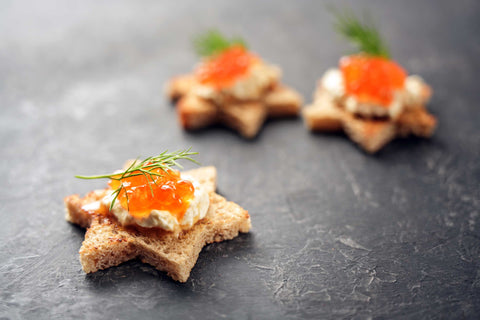Caviar may be synonymous with luxury, but that doesn’t mean it should feel intimidating. Once fish roe is processed, salted, and ready for consumption, it opens a world of culinary possibilities—whether spooned straight from the tin or elegantly layered atop crème fraîche and blinis. While there’s no single “correct” way to enjoy caviar, a bit of guidance can go a long way in elevating the experience. Let’s explore how to eat caviar: what to eat with it, how to serve it, and what tools make the moment shine.
The “Right Way” to Eat Caviar
Tradition tells us to enjoy caviar in its purest form—unadulterated and in small, measured spoonfuls. While purists may argue for minimalist presentation, today’s caviar culture welcomes creativity and indulgence. That said, there are a few timeless techniques worth noting.
Caviar is typically savored in small portions, often less than a tablespoon at a time. It’s not about volume—it’s about appreciation. Resist the urge to chew. Instead, let the pearls gently roll across your palate. Press them softly with your tongue to release their buttery flavor and signature pop. Between bites, cleanse your palate with chilled vodka or a crisp champagne to allow the next taste to shine.
Whether served at an elegant dinner party or enjoyed as a spontaneous treat, caviar deserves to be relished slowly, with attention to texture and temperature. It’s less about rules and more about respect for the craft.
What to Eat With Caviar
From traditional to inventive, caviar’s best pairings are those that enhance without overpowering. Here are some options to choose from:
- Carbs: Start with a simple base like a warm blini, toasted baguette slice, or even a plain kettle chip. These carriers offer a subtle crunch without masking the caviar’s complexity.
- Dairy: Crème fraîche is a classic partner—its richness balances the salinity of the roe. Unsalted butter, sour cream, or whipped cream cheese can also add depth.
- Garnishes: Light, fresh toppings like chopped chives, finely diced red onion, or crumbled hard-boiled egg bring color and texture.
- Creative twists: For a modern take, spoon trout roe over a bagel with cream cheese in place of lox—or add a dollop to a deviled egg or sushi roll.
- Drinks: Caviar pairs beautifully with dry champagne, vodka, or crisp white wines like Chablis or Sauvignon Blanc. Avoid sweet, fruity, or overly acidic options that compete with the delicate roe.
No matter your preferences, the key is balance—let the caviar be the star.
How to Serve Caviar
Proper presentation ensures your caviar doesn’t just taste exquisite—it feels special, too. Caviar should be served chilled, ideally between 26°F and 34°F. Place the tin in a non-reactive bowl nestled in crushed ice, and only uncover it when ready to serve. Heat and air are its biggest enemies, so keep it covered when not in use.
Always use non-metallic serving utensils, such as mother-of-pearl, bone, shell, or glass. Metals like silver can react with the roe and alter its taste. View our collection of serving ware for a few different options. For portioning, a good rule of thumb is ½ to 1 ounce per guest, depending on how it's being served. For garnishes or tasting portions, 5–10 grams will suffice.
Serving styles:
- Classic: On a blini with crème fraîche.
- Modern: As a “caviar bump” served on the back of your hand—a playful nod to Russian tradition.
- Minimalist: Straight from the tin, with a pearl spoon and a glass of vodka nearby.
Always inspect your caviar before serving. It should have a fresh, ocean-like scent—never musty or off-putting.
Caviar Serving Sets
To serve caviar beautifully, invest in tools designed specifically for the job. A dedicated caviar server—often with a built-in ice tray—keeps the roe at its ideal temperature and elevates the presentation. Delicate spoons made of non-reactive materials (like mother of pearl) protect the roe’s flavor while adding a touch of sophistication.
Even if you're enjoying caviar at home on a Tuesday night, the right tools can turn the moment into a small celebration. Whether you're hosting friends or treating yourself, these thoughtful touches regarding how to eat caviar make all the difference.
With the right pairings, tools, and care, caviar can be the center piece of a stunning culinary experience—or a quietly luxurious indulgence. However you choose to enjoy it, let it be intentional, delicious, and completely your own. Buy caviar online today and make your next meal memorable!



